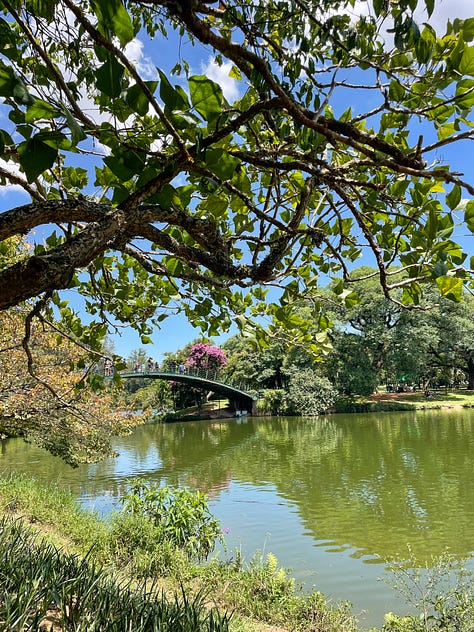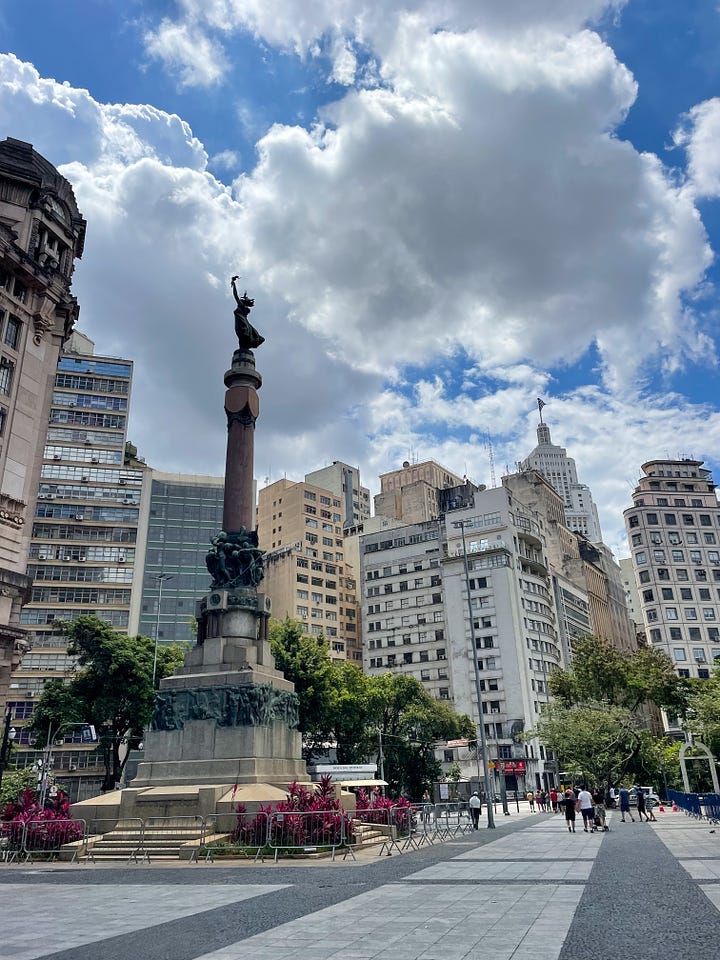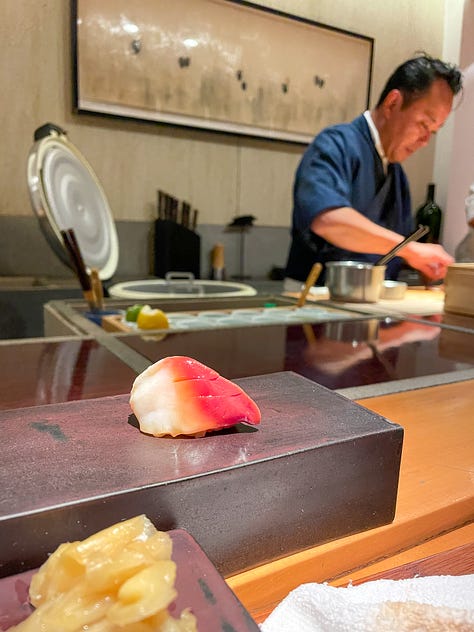Expectations, second chances, and Japanese immigration
Journal Entry #8: Jan 30th 2023, São Paulo Brazil
Hola and welcome to Where on Planet Earth! In case you got here by accident and are not yet a subscriber, sign up below! For more visuals on our travels please follow us on IG @whereonplanetearth
We are arriving to Cartagena tonight, so my plan was to write about Colombia for today's post. About my desire to visit the country - specifically the Caribbean coast of this nation - and why. On how I grew up separated from Colombia by much more than just a physical border, but also by drug wars and politics. But then we spent almost a week in São Paulo, the largest city in Latin America and the world's southern hemisphere, and I am too (surprisingly) enamored with it to not write about it. Hence, my Colombian speech will have to wait.
The one and only time I came to São Paulo was around five years ago for a couple of days, and I hugged a toilet for most of the time. I didn't see much more than what was visible out of the tiny window of my hotel room, and of course, the tiles of the bathroom. Besides, I hadn't come to São Paulo woefully excited about the place and wanting to see much of it. I had written the place off before I set foot in it. It had a bad reputation: "An industrial city", "not pretty", "too much traffic and crime". Truthfully, I only tagged along Alan's business trip to Brazil because I wanted to go to Rio, my sun-kissed sandy darling. But of course his business meetings were in São Paulo, so here I was, on a date with the toilet.
I hated São Paulo as much as I convinced myself to hate it long before I set foot in it.
Expectations matter. A lot. Traveling will often teach you this through both overt and subtle lessons. Don't expect a place to be incredible, as it will likely disappoint you. But also, don't hate a place before you step foot in it, as you might fall in love with it. Having no expectations is helpful in allowing you to experience a place just as it is. But, this is almost impossible! You are going there for one reason or the other, and that it itself brings inherent expectations. I think the goal is to be somewhere in the middle, knowing every place on earth has good and bad and allowing it to show you its different faces. Always expecting to see both sides of the coin, and then choosing what to focus on.
As we do a walking tour of the downtown of São Paulo I can't stop overhearing this man go on and on about why he hates this city. "This place has no heart" he exclaims. But I see heart in the curious eyes of strangers, in the flowing leaves of trees, in the samba music carried by the wind. "It's so messy!", he continues. I think this through for a minute, and come to the conclusion that I like messy. I have never been particularly into very orderly places and societies. They make me feel inadequate, uncomfortable, like I cannot be my messy unique self. So I will take a Sao Paulo, or a Hanoi, or a New York, or a Mexico City, any day of the week over a Stockholm, or a Santiago, or a Singapore, or a Helsinki. Don't get me wrong, I like these places, but I don't love any of them.









My point is that each of us create our own little stories about places and what they represent to us. And the truth is that I have always been an optimist. I choose to see the good side of almost any place. I criticize all of them too, and there are very few places I haven't liked, but my emphasis is always on the positive. Because there is good *everywhere*, I promise you. And more and more I am learning that even the places I didn't like, I should give second chances to. Because they might surprise me, like São Paulo did.
Here are a few reasons why I liked it so much:
It's much greener than I expected it to be. There are these fantastical looking trees - I think called Tipuana - all over the city, reaching to the sky with their twisted arms. And there are big and small lush parks dotting the city.
The are so many world-class museums! with impressive exhibitions, art, design, and information. Sure, many are only in Portuguese, which is a shame, but Google Translate can save the day.
There is art, everywhere! Murals adorns many buildings facades and you can’t walk a block without seeing street art
It's a large city, but extremely manageable. You can walk to many places, and getting around in metro or Uber is a breeze. We weren't stuck in traffic a single time in an entire week there, even though we went all over the city in Ubers. I still don’t understand how this is possible in a city of more than 20M people.
Related to the above point, there is no pollution! Again, very surprising for a city this size.
The food is incredible, and a lot more cosmopolitan than what you can find in Rio. Authentic Asian cuisine is in every corner, as well as exquisite Brazilian fare for all budgets.
It's alive, and yes, MESSY! in a wonderful way.
There are a few big cities in the world that, to us, fit into a certain category. Cities that make us want to walk them, that we feel comfortable in, that are pretty in their own way, that have good food and kind people, that are dynamic and cosmopolitan. São Paulo is now part of this group, as well as Tokyo, Mexico City, New York, London, Buenos Aires, and Berlin. There are many other cities we love for various reasons, but these are the "big" ones that hit all the marks.
Btw, I am not saying São Paulo is perfect! Unfortunately, there is a large homeless population in downtown (like in most other big cities around the globe). There is also crime (although we didn't experience it at all). The downtown area is pretty run down. But no place is perfect, right?




Ok, so I kind of digressed with all the above as my plan was to share a few interesting learnings from the museums we visited this week (which were many!). I will focus on the Japanese Immigration Museum since it was so captivating. Here goes a bit of history!
Sao Paulo holds the largest Japanese population outside Japan! This was surprising to me, as I grew up thinking Peru was the Latin American country with the largest Japanese community, but it turns out the immigration was tiny in comparison with Brazil's. It's true that Peru was the first South American to accept Japanese immigration in 1899, but Brazil followed soon after and received many more immigrants (almost 250,000 from 1908 to 1984). Nowadays only around 100,000 people in Peru self-identify as being Nikkei (of Japanese ancestry), versus 2 million in Brazil!




In the second half of the 19th century Brazil went through a huge transformation when coffee replaced sugarcane and mining as the main economic driver, slavery was abolished, and the monarchical system was overthrown for the establishment of the republic. Without slaves the work on the coffee farms needed to be done by immigrants. Initially, European - mostly Italian - but with poor working conditions that migration route dwindled. At the same time Japan was going through its own sets of challenges, with lots of people living in poverty. With Brazil facing difficulty attracting European immigrants and Japan dealing with increased misery among its population, a match was made, and Japan started to send people to Brazil to work on the coffee farms.
Decades passed and immigration continued. The Japanese settled in several Brazilian states and started to buy land and successfully farmed cotton, black pepper, tea, silk, jute, etc. They introduced various products that didn’t exist in Brazil, and also revolutionize cultivation techniques.
Then the 1930s rolled around, and racist ideas rose in the country following what was happening in Europe. A law was enacted to restrict Japanese immigration and also to prohibit the teaching of the Japanese language to children under 14 years. With the outbreak of WWII the situation worsened and it soon became forbidden to meet in groups, to speak Japanese in public, and to get around without a safe conduct. Life for Japanese immigrants become increasingly difficult. They were considered enemies, as it also happened in the United States.

Much later, in the 1950s, the relationship between the two countries stabilized and a new wave of immigrants came into the country. Japan was also developing at an extraordinary rate and this led to a boom in the arrival of large Japanese companies to Brazil, including Mitsubishi, Toyota, and others. These were “golden” years for both countries. Until the 1980s, when Brazil entered a deep economic downtown while Japan enjoyed great economic expansion. So, a reverse migration occurred, with many Brazilian Japanese going back to Japan. Nowadays more than 200,000 Brazilian Nikkei live in Japan.
Today, more than 2 million people in Brazil self identify as Nikkei, that is 1% of the entire population of the country! Most live in São Paulo and their influence is obvious. My favorite influence of all? THE FOOD! Honestly I have never been in a city outside Japan with more (truly delicious and authentic) Japanese restaurants in my life.






We visited many other very informative museums and learned a ton from them. When in Sao Paulo don’t miss going to:
Museum of Art of São Paulo
Xingu Museum
Museu Afro Brasil
Memorial Resistance of São Paulo
Museu da Lingua Portuguesa
Farol Santander
Oh and don’t forget to give places second chances, they might surprise you :)
Fin.





Tu entusiasmo por Sao Paulo es contagioso, es una invitacion a visitar esa exuberante ciudad .
Provoca visitar sus excelentes museos, descubrir el arte que adorna sus calles y edificios, escuchar su alegre musica , deleitarse con sus bailes y ritmos y la excelente gastronomia .
La describes muy bien, una ciudad vibrante y rica en museos, parques , verdor y gente afable.
Muy interesante e informativo. Muy bien escrito y detallado. Las recomendaciones seran muy utiles para los que viajen a esta ciudad. Gracias por compartir tan buena informacion.